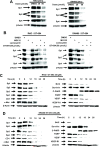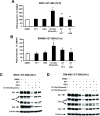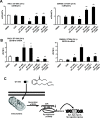GT-094, a NO-NSAID, inhibits colon cancer cell growth by activation of a reactive oxygen species-microRNA-27a: ZBTB10-specificity protein pathway
- PMID: 21156786
- PMCID: PMC3069691
- DOI: 10.1158/1541-7786.MCR-10-0363
GT-094, a NO-NSAID, inhibits colon cancer cell growth by activation of a reactive oxygen species-microRNA-27a: ZBTB10-specificity protein pathway
Abstract
Ethyl 2-((2,3-bis(nitrooxy)propyl)disulfanyl)benzoate (GT-094) is a novel nitric oxide (NO) chimera containing an nonsteroidal anti-inflammatory drug (NSAID) and NO moieties and also a disulfide pharmacophore that in itself exhibits cancer chemopreventive activity. In this study, the effects and mechanism of action of GT-094 were investigated in RKO and SW480 colon cancer cells. GT-094 inhibited cell proliferation and induced apoptosis in both cell lines and this was accompanied by decreased mitochondrial membrane potential (MMP) and induction of reactive oxygen species (ROS), and these responses were reversed after cotreatment with the antioxidant glutathione. GT-094 also downregulated genes associated with cell growth [cyclin D1, hepatocyte growth factor receptor (c-Met), epidermal growth factor receptor (EGFR)], survival (bcl-2, survivin), and angiogenesis [VEGF and its receptors (VEGFR1 and VEGFR2)]. Results of previous RNA interference studies in this laboratory has shown that these genes are regulated, in part, by specificity protein (Sp) transcription factors Sp1, Sp3, and Sp4 that are overexpressed in colon and other cancer cell lines and not surprisingly, GT-094 also decreased Sp1, Sp3, and Sp4 in colon cancer cells. GT-094-mediated repression of Sp and Sp-regulated gene products was due to downregulation of microRNA-27a (miR-27a) and induction of ZBTB10, an Sp repressor that is regulated by miR-27a in colon cancer cells. Moreover, the effects of GT-094 on Sp1, Sp3, Sp4, miR-27a, and ZBTB10 were also inhibited by glutathione suggesting that the anticancer activity of GT-094 in colon cancer cells is due, in part, to activation of an ROS-miR-27a:ZBTB10-Sp transcription factor pathway.
Figures






References
-
- Elwood PC, Gallagher AM, Duthie GG, Mur LA, Morgan G. Aspirin, salicylates, and cancer. Lancet. 2009;373:1301–9. - PubMed
-
- Thun MJ, Henley SJ, Patrono C. Nonsteroidal anti-inflammatory drugs as anticancer agents: mechanistic, pharmacologic, and clinical issues. J Natl Cancer Inst. 2002;94:252–66. - PubMed
-
- Baron JA. Epidemiology of non-steroidal anti-inflammatory drugs and cancer. Prog Exp Tumor Res. 2003;37:1–24. - PubMed
Publication types
MeSH terms
Substances
Grants and funding
LinkOut - more resources
Full Text Sources
Other Literature Sources
Research Materials
Miscellaneous

